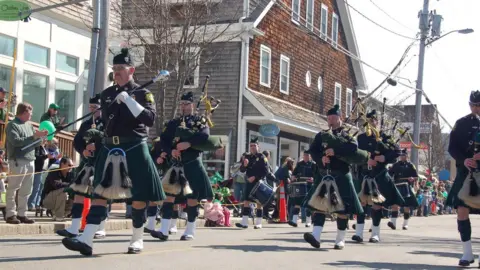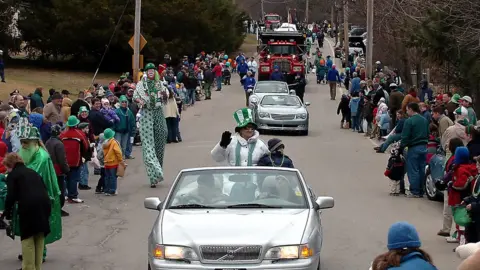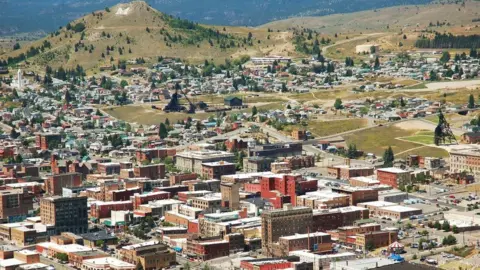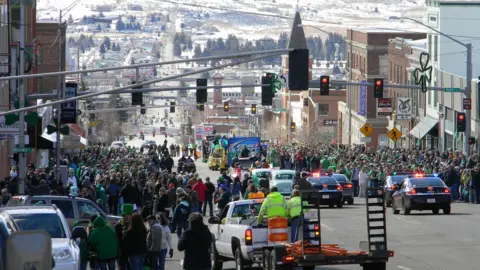St Patrick's Day: America's most Irish towns celebrate
 Siobhan Hunter
Siobhan HunterWhen you think about Irish-America, the first place that probably comes to mind is Boston.
Or maybe, when St Patrick's Day approaches, you'd think of the parade in New York or the Chicago River being dyed green.
However, there is a city and a town that both lay claim to be America's most Irish and chances are you may not have heard of either.
One is a former mining city in the north west and the other a town in the heart of America's "Irish Riviera".
According to the 2010 census, the Massachusetts coastal town of Scituate is home to a higher concentration of people who trace their ancestry back to Ireland than any other town or city in the United States.
Just under half of the town's population said they were of Irish heritage, although that figure dropped slightly in 2020.
 Teresa Scott
Teresa ScottThe figure in Plymouth County, in which the town is situated, stands at slightly more than 30% Irish-American.
The South Shore of Massachusetts is an area stretching from south of Boston to Cape Cod, which has been affectionally referred to as the "Irish Riviera" for many years.
Between 1820 and 1930, it is estimated that as many as 4.5m Irish people arrived in America.
While large numbers of emigrants from Ulster in the 1700s settled in the Appalachian region and southern states, many of the newer emigrants settled in the north east.
In the 1850s a Boston fisherman and Irish immigrant, Daniel Ward, found Irish moss, also known as carrageenan, growing beneath the rocks on Scituate's shores.
 ROBIN CHAN/WICKED LOCAL
ROBIN CHAN/WICKED LOCAL It was not only a potential food source, but was also used as a thickening agent used in cosmetics, desserts, beer, paint, and more. This was the beginning of the Irish mossing industry on the South Shore.
Later, with its proximity to Boston, Irish-American residents of that city holidayed, bought second homes and in many cases permanently relocated to Scituate and the surrounding towns on the South Shore.
Siobhán Hunter, of the Scituate Sister City West Cork Committee and whose father was originally from Belfast, says "Irishness has been instilled in our everyday lives here".
"It is a part of us," she adds.
"You'll see Irish surnames on businesses all around town and the South Shore, Irish flags hung all year round, painted Irish flags on pedestrian walks in Sand Hills, an annual Easter Rising Memorial and now permanent monument in our harbour."
 Siobhan Hunter
Siobhan HunterThe town, which has a population of about 19,000 also, of course, pulls out all the stops for St Patrick's Day.
"We have a massive St Patrick's Day parade that attracts 15,000 to 20,000 people from all over," says Siobhán.
"We tend to enjoy at least a week of celebrations and find that most everyone joins in on the spirit of St Patrick's Day, in one way or another.
"We are a country that is made up of generations of immigrants, from all over the globe. Therefore, it's not just about celebrating contributions of Irish, but all immigrants."
Scituate has been "sistered" or "twinned" with the West Cork area of Ireland since 2016.
 Siobhan Hunter
Siobhan Hunter"We have a cultural exchange, which includes everything from delegations to marketing ideas, coastal flood management, environmental science, as well as student exchanges," Siobhán says.
"From the Scituate West Cork Sister City Committee also spawned the idea of the South Shore Irish Heritage Trail, inspired by Ireland's Wild Atlantic Way.
"It is the hope to not only educate people that live in these areas as to the contributions and sacrifices of Irish and Irish-Americans, but also people from all over the world."
While Scituate can claim the title of most Irish town in the US, Butte, Montana, has often been referred to as the most Irish city in the country.
Around a quarter of Butte's population claim Irish heritage. but the influence of Irish culture on the former mining town's history is also important.
 Teresa Scott
Teresa ScottTeresa Scott of the Montana Gaelic Cultural Society says the main reason so many Irish came to live in Butte is copper.
"Butte is a mining town and copper was king in the late 1800s and early 1900s," she says.
"Irish came to work the copper mines in Butte and the surrounding area."
The Montana Gaelic Cultural Society sponsors language immersion weekends, the An Ri Ra Montana Irish Festival and gives grants to educational groups that promote Irish music, dance and heritage.
"We don't just represent the Irish, but all Celtic nations," Teresa says.
 Teresa Scott
Teresa ScottMike O'Connor of the Montana Ancient Order of Hibernians says in its time Butte has had more people per capita with Irish decent than any other city in the United States and still retains the sense of Irishness.
He added that there are St Patrick's Day parades throughout Montana.
"Also at our state capitol in Helena we raise the Irish flag on St Patrick's Day.
"We have been doing this for 37 years. We are the only capitol in the United States to do this."
Teresa describes St Patrick's Day, when the city's population of 35,000 people is swollen by thousands of visitors, as "the high holy day in Butte".
"It's celebrated on 17 March with a parade, dancing, music, food and drink," she says.
"In Butte you can walk around with your beverage in public and with spring break falling in the same week, it gets a bit rowdy in uptown Butte, especially if it's a sunny day with no wind or snow.
"There is a family friendly event in the evening called Handing Down the Heritage where we have local Irish dancers and bands, along with bagpipers. It's a grand time.
"Other cities have parades and Irish dancers and music, but Butte is where everyone wants to be."
 Teresa Scott
Teresa ScottLike Scituate, she says other ethnic groups join in the St Patrick's Day celebrations.
"Butte is very ethnically diverse," Teresa says.
"Many different nationalities came to work in the mines and stayed - Italians, Finnish, Serbians, Chinese, Norwegian, Croatian, Greek, Lebanese, Welsh and Cornish.
"On 16 March Butte celebrates the Finnish St Urho Days. He chased the grasshoppers, some say frogs, out of Finland.
"It is the precursor for the St Patrick's Day celebration."
So while there may be debate as to who can claim the title of America's most Irish town, what is certain is that after Covid restricted events last year, this year's St Patrick's Day events will be celebrated with even more gusto than usual.
